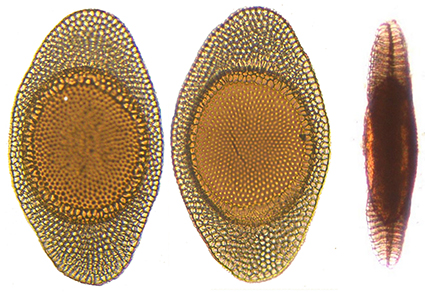Abstract
A bryozoan survey conducted in the Amazon Basin in the vicinities of Manaus and Santarém during the high water season (May, 2018) revealed four new species described here: Fredericella adrianoi n. sp., Plumatella divae n. sp., Plumatella hartikainenae n. sp., and Plumatella spencerjonesae n. sp. Two of these species were encountered only once, suggesting that other undescribed species are likely to occur in the area. Range extensions were determined for two additional species: Plumatella pirassununga and Timwoodiellina natans. In addition, colonies were collected for the first time for two species previously known only by their statoblasts: Plumatella siolii and Plumatella marcusi. Statoblasts of Tapajosella elongata were encountered near Manaus, but the colonies remained elusive. The discovery of new species collected during two expeditions to the Amazon Basin in different seasons and years suggests that further diversity remains undetected in this and other poorly studied regions of the world. With few exceptions, plumatellid colonies described so far from the Amazon Basin are very similar in appearance, with branches wholly attached to the substratum and body walls that are soft, colorless, and transparent.
References
Brown, J.H., Mehlman, D.W. & Stevens, G.C. (1995) Spatial variation in abundance. Ecology, 76 (7), 2028–2043. https://doi.org/10.2307/1941678
Bushnell, J.H. (1965) On the taxonomy and distribution of freshwater Ectoprocta in Michigan. III. Transactions of the American Microscopical Association, 84 (4), 529–548. https://doi.org/10.2307/3224799
Hartikainen, H., Waeschenbach, A., Wöss, E., Wood, T. & Okamura, B. (2013) Divergence and species discrimination in freshwater bryozoans (Bryozoa: Phylactolaemata). Zoological Journal of the Linnean Society, 168(1), 61–80. https://doi.org/10.1111/zoj.12025
d’Hondt, J-L. (2014) Addendum et Corrigendum aux “Tabular Keys for Identification of the Recent Ctenostomatous Bryozoa” (1983). Bulletin de la Société Zoologique de la France, 139(1–4), 143–197.
Kraepelin, K. (1906) Eine Süsswasserbryozoë (Plumatella) aus Java. Mitteilungen aus dem Naturhistorischen Museum in Hamburg, 23, 143–46.
Mané-Garzón, F. (1960) Una nueva especie del género Hislopia (Bryozoa Ectoprocta) del Uruguay. Actas y trabajos del Primer Congreso Sudamericano de Zoología, 2 (3), 213–216.
Oka, A. (1890) Observations on freshwater Polyzoa (Pectinatella gelatinosa n. sp.). Journal of the College of Science of the Imperial University of Japan, 4, 89–150.
Okamura, B., Hartikainen, H. & Trew, J. (2019) Waterbird-mediated dispersal and freshwater biodiversity: General insights from bryozoans. Frontiers of Ecology and Evolution, 7, 29. https://doi.org/10.3389/fevo.2019.00029
Potts, E. (1884) On Paludicella erecta. Proceedings of the Academy of Natural Science, Philadelphia, 36, 213–214.
Rogick, M.D. (1945) Studies on freshwater Bryozoa. XVI. Fredericella australiensis var. browni, n. var. Biological Bulletin of Woods Hole, 89 (3), 215–228. https://doi.org/10.2307/1538331
Ruggeri, P., Pasternak, E. & Okamura, B. (2019) To remain or leave: Dispersal variation and its genetic consequences in benthic freshwater invertebrates. Ecology and evolution, 9 (21), 12069–12088. https://doi.org/10.1002/ece3.5656
Wiebach, F. (1967) Amazonische Moostiere (Bryozoa). Amazoniana, 1 (2), 173–187.
Wiebach, F. (1970) Amazonische Moostiere (Bryozoa) II. Amazoniana, 2 (3), 353–362.
Wiebach, F. (1974) Amazonische Moostiere (Bryozoa) III. Amazoniana, 5(2), 293–303.
Wood, T.S. (2005) Study methods for freshwater bryozoans. Denisia, 16, 103–110.
Wood, T.S. (2015) Phyla Ectoprocta and Entoprocta (Bryozoans). In: Thorp, J.H. & Rogers, C. (Eds.), Thorp and Covich’s Freshwater Invertebrates. Vol. 1. Ecology and General Biology. Elsevier, s.n., pp. 327–345. https://doi.org/10.1016/b978-0-12-385026-3.00016-4
Wood, T.S. (2019) Phylum Ectoprocta. In: Rogers, D.C. & Thorp, J.H. (Eds.), Thorp and Covich’s Freshwater Invertebrates. Vol. 4. Keys to the Palaearctic Fauna. Academic Press, London, pp. 519–529. https://doi.org/10.1016/B978-0-12-385024-9.00013-7
Wood, T.S. & Okamura, B. (1999) Asajirella gelatinosa in Panama: a bryozoan range extension in the Western Hemisphere (Ectoprocta: Phylactolaemata). Hydrobiologia, 390, 19–23. https://doi.org/10.1023/A:1003502814572
Wood, T.S., Anurakpongsatorn, P. & Mahujchariyawong, J. (2006a) Swimming zooids: an unusual dispersal strategy in the ctenostome bryozoan, Hislopia. Linzer Biologische Beiträge, 38 (1), 71–75.
Wood, T.S., Anurakpongsatorn, P. & Mahujchariyawong, J. (2006b) Freshwater bryozoans of Thailand (Ectoprocta and Entoprocta). The Natural History Journal of Chulalongkorn University, 6 (2), 83–119.
Wood, T.S. & Okamura, B. (2017) Four new species and two range extensions for freshwater bryozoans in Brazil: the tip of the iceberg? Zootaxa, 4306(3), 383–400. https://doi.org/10.11646/zootaxa.4306.3.5
Zhou, Z. (2020) A Genome-skimming Molecular Phylogeny of Ctenostomata (Bryozoa: Gymnolaemata). Master Thesis, Imperial College, London, 36 pp.


